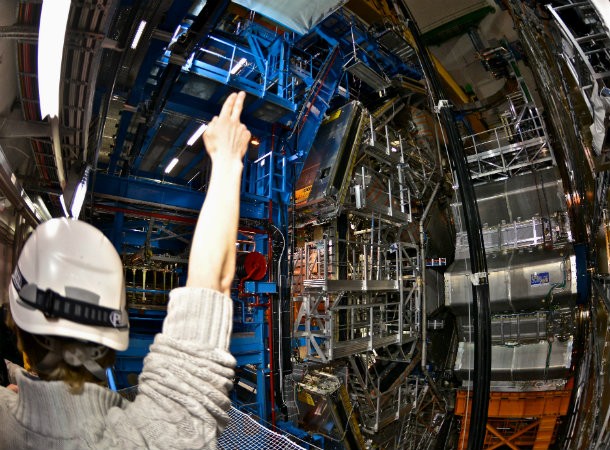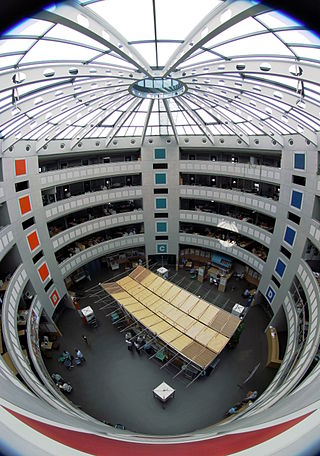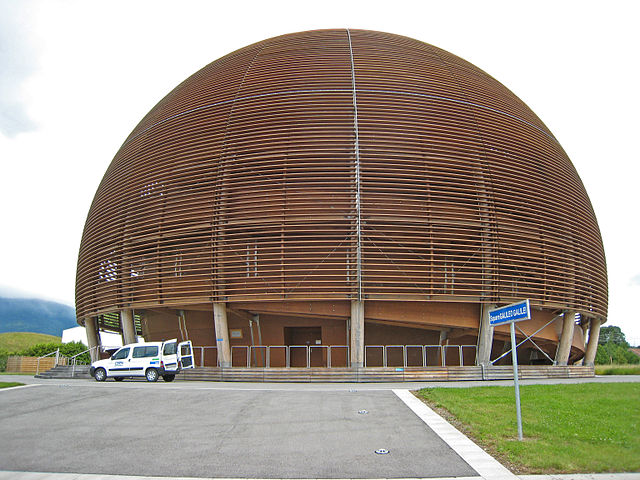
Inside CERN's ATLAS Cavern, located 92 m. below ground. Photo Credit: Calcalist
GENEVA — In a way, the worst thing that could have happened for physicists at CERN, the world's largest particle physics research center, was discovering the holy grail of physics — the so-called God particle, also known as Higgs boson.
Because after finding it in July 2012 — and confirming it six months later, after almost 50 years of searching — what else is left? The anti-climax was inevitable.
Sure enough, the world is far less interested in this project, and much less money is being invested in it. It's somewhat like the fate of the American space program after the moon landing, which achieved its goal by preceding the Russians.
Now CERN, or the European Organization for Nuclear Research, is closing temporarily for 18 months of renovations. But before that, in late April, I arrived there with about 10 other Israeli journalists for a visit funded and organized by the Israeli National Academy of Sciences. During a 72-hour blitz, we were taken to places where people are stretching human understanding, and the technology that enables it, to their limits.
Over 4,000 researchers from around the world work together, like a collective brain, in an environment filled with wires extending through millions of impossible connections, monstrous magnets, shafts, passageways, liquid nitrogen tanks, complex safety mechanisms, and ominous emergency doors. It's an insane cyborg that has been devoted for decades to the most expensive and extravagant quest in history — for a single particle, which most of humanity doesn't even care about.
“The question I hear most often regarding our work here at CERN is, 'Why should we care about all of this? What can be done with it? How much money can you make out of it?'” Professor Eilam Gross says at the beginning of his lecture on the first day of our visit. “In one Norwegian newspaper, they even asked if it can help cut beer prices.”
Gross, a faculty member at the Weizmann Institute of Science and one of the most senior Israelis involved in the CERN project, quickly moves to the decisive answer. “Truth is, I don't mind it because the science we do here is motivated by curiosity,” he says. “Had we been doing only applied science all our life, we'd still be using candles for light. They might have been very sophisticated candles, but candles nonetheless. Curiosity breeds knowledge, and this is why I give this talk — because we need your help in explaining to the world that knowledge is infinite and we have to move on. And for this, we need funding.”
Tiny but important
The Higgs boson has been the missing link in the standard model of physics all these years, the one that could describe the entire material world, the particle that gives mass to everything.
After using an older-generation particle accelerator for decades, CERN established the world's largest and most expensive particle accelerator in the 1990s — in a 27-kilometer, ring-like underground tunnel spanning the border of Switzerland and France.
This grand facility is responsible for accelerating protons at the closest possible speed to light speed, with the highest energy humans have ever achieved (the one that appeared a fraction of a second after the Big Bang), in a place that is at once the hottest in the universe (at the point where protons collide) and the coldest in the universe (around the gargantuan magnets intended to force the protons to keep moving in circles and not “fly” outside).

Inside of CERN office building 40 (Photo-Gilles Danielson)
During the searching stage, it was easier for politicians and the public to accept the costs of such science. But since the breakthrough discovery two years ago, it’s been more difficult to convince people about the need to continue investing. But many questions remain unanswered: Does only one such particle exist, or could there be a number of different Higgs bosons? How can it be characterized? And what do we actually have here?
To identify the subatomic particle, scientists have to dramatically increase the number of significant collisions between the protons they accelerate, CERN's Director General Rolf-Dieter Heuer explains.
Creating such significant collisions requires massive energy — more than twice the already staggering amount of energy currently used at CERN. For that, researchers need an entirely new technology, a 100-kilometer tunnel instead of the existing 27-kilometer one, and stronger magnets.
Heuer doesn't put a number on the potential costs, but if the current accelerator cost more than $6 billion, the next one could easily be priced at more than $10 billion. And that's over and above the $1.35 billion of planned maintenance.
The annual budget relies on member fees paid by each of the 21 countries participating in the project. Each contribution is relative to the country's GDP, which makes Germany, France, Spain and Italy the main funders, together responsible for 55% of the budget.
The economic downturn has already caused a $300 million budget cut in 2010. Since then, as some contributing countries struggle with debts and record unemployment, explaining why it's important to continue funding the project has become even more urgent. For CERN scientists, the fight for funding is constant, both in the media and with decision makers.
The thinkers
The next generation of Israeli scientists working at CERN — some PhDs, some doing post-doctorate work — are studying all kinds of physics. One is looking for dark matter, another is searching for other dimensions. Seriously.
I wake up in the morning and type words into a computer program, and he's looking for other dimensions. Not that I would have wanted to search for dark matter, but I sure envy people whose entire world is confronting a non-stop intellectual challenge that's half abstract, half fantastic.
These young scientists are not yet infected by politics, and don't yet have to deal with funding. They focus only on their research, visiting CERN every few weeks or months, building detectors, renewing theories, conducting analyses.
I asked each of them, separately, why do what they do. Yan Benhammou, 44, an expert in nuclear and particle physics from Tel Aviv University, is reponsible for developing the next generation of detectors. “If tomorrow we stop doing what we do here, no one in the world would notice,” he says. “It's not like someone who's searching for a cure for cancer. It would make no difference to anyone if there is one more or one less particle. Most people don't even understand what we do. But because we do things that are at the edge of technology, it is important because we constantly push the envelope on electronics and computing.”

Globe of Science and Innovation at CERN (Photo - Adam Nieman)
All of our conversations with scientists and officials on the CERN campus followed this line: The research done here is indeed science for the sake of science, but it can be used for many economic benefits. It is a sort of artificial effort to turn something done for its own sake into something that can be translated into a bottom line.
Professor Giora Mikenberg, another senior Israeli scientist who's heading the Israeli detector development team in one of the experiment stages for the accelerator, says that participating in CERN can be beneficial for Israeli industry. First, he says, the Economy Ministry investment is returned to Israeli industry because it is conditioned by the purchase of certain components from Israeli companies. Second, the experience and reputation that companies get by taking part in the project — either through supplying equipment for detectors or by providing advanced soldering services — also makes for opportunities into new markets.
And if those reasons aren't enough to continue investing in this mad project, Mikenberg rightly adds that CERN research is constantly pushing the boundaries of technology and electronics, leading to new developments that can in turn be used for completely other things.
There are two examples for things that came out of CERN — in fact, the only two examples that were repeatedly mentioned. One is the Internet, which was invented here 25 years ago. Another is the PET CT, a medical instrument for detecting cancerous tumors.
The particle accelerator is similar to the space race and the incredible developments it brought about amid broad criticism over its huge expenses. So the Higgs boson is the new moon. When thinking of it this way, it's easier to understand the magic.
